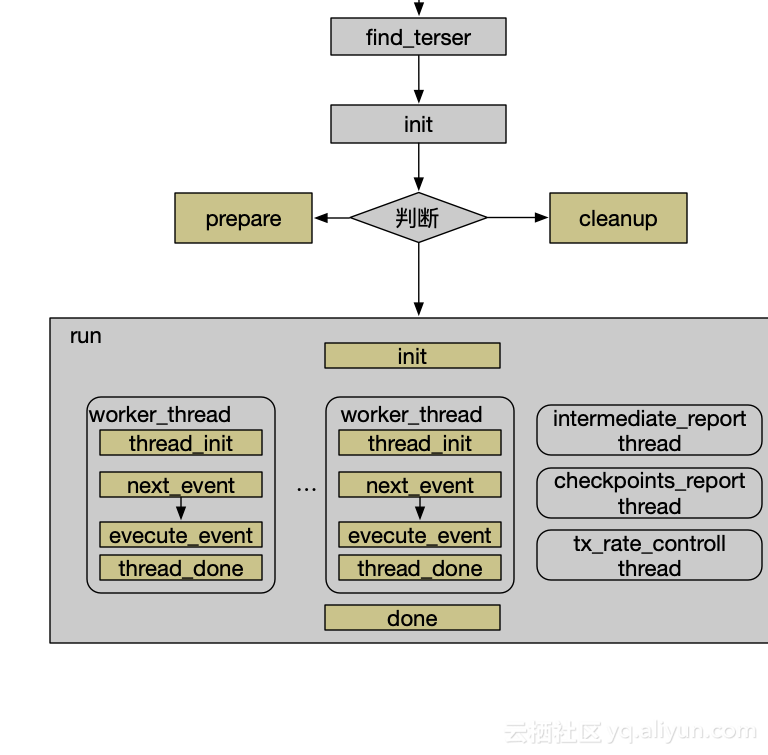sysbench是一个非常经典的综合性能测试工具,它支持CPU,IO,内存,尤其是数据库的性能测试。那它是怎么做到通用性的呢,总结一句话是大量运用了重载的方法。
sysbench总体架构
sysbench是一个总体框架,它用来操作各个测性能的计算,那各个部门只需要做的一件事情是声明需要的实现。只要理解了这三个struct就可以了:
/* 某个测试用例的整体结构 */
typedef struct sb_test
{
const char *sname;
const char *lname;
/* 下面有具体说明 */
sb_operations_t ops;
sb_builtin_cmds_t builtin_cmds;
sb_arg_t *args;
sb_list_item_t listitem;
} sb_test_t;
/* 某个测试用例的具体操作实现结构 */
typedef struct
{
sb_op_init *init; /* initialization function */
sb_op_prepare *prepare; /* called after timers start, but
before thread execution */
sb_op_thread_init *thread_init; /* thread initialization
(called when each thread starts) */
sb_op_print_mode *print_mode; /* print mode function */
sb_op_next_event *next_event; /* event generation function */
sb_op_execute_event *execute_event; /* event execution function */
sb_op_report *report_intermediate; /* intermediate reports handler */
sb_op_report *report_cumulative; /* cumulative reports handler */
sb_op_thread_run *thread_run; /* main thread loop */
sb_op_thread_done *thread_done; /* thread finalize function */
sb_op_cleanup *cleanup; /* called after exit from thread,
but before timers stop */
sb_op_done *done; /* finalize function */
} sb_operations_t;
/* 某个测试用例的三阶段实现结构 */
typedef struct
{
sb_builtin_cmd_func_t *help; /* print help */
sb_builtin_cmd_func_t *prepare; /* prepare for the test */
sb_builtin_cmd_func_t *run; /* run the test */
sb_builtin_cmd_func_t *cleanup; /* cleanup the test database, files, etc. */
} sb_builtin_cmds_t;拿最简单的CPU性能计算举例,它需要实现的是:
static sb_test_t cpu_test =
{
.sname = "cpu", /*case简称*/
.lname = "CPU performance test",/*case全称*/
.ops = {
.init = cpu_init, /* 初始化case */
.print_mode = cpu_print_mode, /* case启动前,做说明 */
.next_event = cpu_next_event, /* 拿到下一个event的数据 */
.execute_event = cpu_execute_event, /* 具体执行这个event */
.report_cumulative = cpu_report_cumulative, /* 阶段性报告输出 */
.done = cpu_done /* case结束后,处理干净 */
},
.args = cpu_args /*子case需要的参数说明*/
};看到这个后,把一个case需要做的事情描述很清楚了,从需要什么参数,到初始化,逐个event执行,函数定义很清晰。sysbench的其他case也都这样需要一个完整的结构说明,如io操作,则需要多一个case的prepare和cleandown声明。
那sysbench的完整流程是怎样呢?黄色部分是测试用例需要实现的。
至此,可以清晰地看到sysbench的框架还是非常好理解。
上面struct里面有个event概念,不同的测试event的定义都不一样:比如CPU的测试case,一个event是完成求得小于某数(默认10000)的所有质数。比如fileio的测试case,一次read或者一次write操作就是一个event。
sysbench的线程介绍
- worker_thread具体实现是怎样呢:欣赏下sysbench.c里面某子线程是如何执行的,代码非常清晰易懂:
static int thread_run(sb_test_t *test, int thread_id)
{
sb_event_t event;
int rc = 0;
while (sb_more_events(thread_id) && rc == 0)
{
event = test->ops.next_event(thread_id);
if (event.type == SB_REQ_TYPE_NULL)
break;
sb_event_start(thread_id);
rc = test->ops.execute_event(&event, thread_id);
sb_event_stop(thread_id);
}
return rc;
}- intermediate_report线程:周期性输出性能数据,参数项为:
--report-interval=N,对CPU的测试用例举例:sysbench cpu --report-interval=1,截取部分输出结果如下:
Threads started!
[ 1s ] thds: 1 eps: 922.10 lat (ms,95%): 1.08
[ 2s ] thds: 1 eps: 925.19 lat (ms,95%): 1.08
[ 3s ] thds: 1 eps: 926.00 lat (ms,95%): 1.08
[ 4s ] thds: 1 eps: 926.00 lat (ms,95%): 1.08
[ 5s ] thds: 1 eps: 926.00 lat (ms,95%): 1.08
[ 6s ] thds: 1 eps: 926.00 lat (ms,95%): 1.08
[ 7s ] thds: 1 eps: 925.00 lat (ms,95%): 1.08
[ 8s ] thds: 1 eps: 926.02 lat (ms,95%): 1.08
[ 9s ] thds: 1 eps: 925.99 lat (ms,95%): 1.08
[ 10s ] thds: 1 eps: 924.98 lat (ms,95%): 1.08每一秒输出一个结果,eps是每一秒的event数,lat单位是毫秒,95分位延迟数据是1.08
- checkpoints_report线程:如果嫌周期性输出不够多,那么可以在某几个时间点整体输出,参数项为:
--report-checkpoints=[LIST,...]
还是对CPU测试用例举例:sysbench cpu --report-checkpoints=3,8 run,截取部分输出结果如下:
Threads started!
[ 3s ] Checkpoint report:
CPU speed:
events per second: 923.01
General statistics:
total time: 3.0001s
total number of events: 2771
Latency (ms):
min: 1.08
avg: 1.08
max: 1.22
95th percentile: 1.08
sum: 3000.88
Threads fairness:
events (avg/stddev): 2773.0000/0.00
execution time (avg/stddev): 3.0009/0.00
[ 8s ] Checkpoint report:
CPU speed:
events per second: 924.47
General statistics:
total time: 8.0001s
total number of events: 4622
Latency (ms):
min: 1.08
avg: 1.08
max: 1.16
95th percentile: 1.08
sum: 4998.04
Threads fairness:
events (avg/stddev): 4621.0000/0.00
execution time (avg/stddev): 4.9980/0.00- tx_rate_controll线程,控制每秒输出量的一个线程:参数项为:
--rate=N,默认是不做控制的。
还是拿CPU测试用例举例,控制每秒跑10个event:sysbench cpu run --rate=10,截取部分输出结果如下:
Running the test with following options:
Number of threads: 1
Target transaction rate: 10/sec
Initializing random number generator from current time
Prime numbers limit: 10000
Initializing worker threads...
Threads started!
CPU speed:
events per second: 8.87 #没那么精准哈输出速率控制在哪里呢?眼尖的人马上可以看到是在sb_more_events函数。那sb_more_events函数主要是做什么呢:
- 判断是否超时,默认是10秒
- 判断是否到达最大event数,如果设置了的话
- 就是速率控制。
综上,大概介绍了sysbench框架的总体实现,关于数据库性能测试容下篇再介绍。